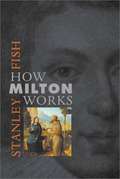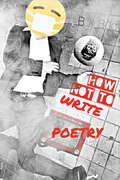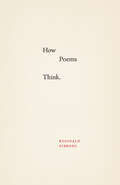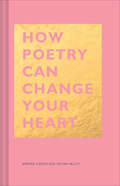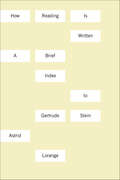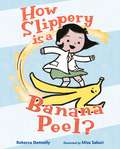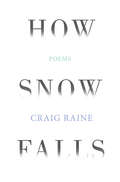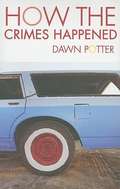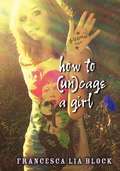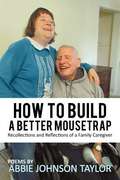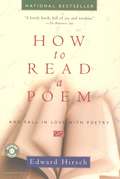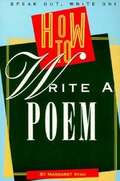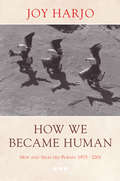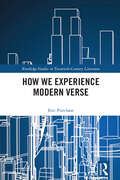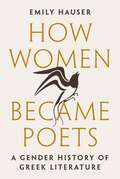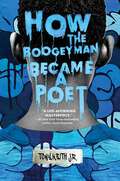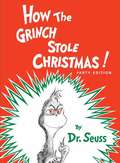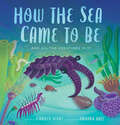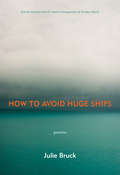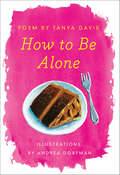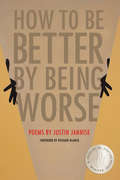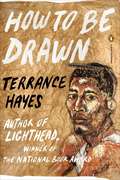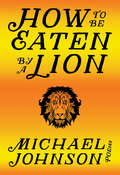- Table View
- List View
How Milton Works
by Stanley FishHow Milton works "from the inside out" is the foremost concern of Fish's book, which explores the radical effect of Milton's theological convictions on his poetry and prose.
How Not To Write Poetry
by Billy Bud Fraser“Random events of my life put into rhyme. A collection of moments and what I was feeling. A glimpse of the crazy that is my mind. Love, loss and some the characters that left an impression.” BILLY BUD FRASER
How Poems Think
by Reginald GibbonsTo write or read a poem is often to think in distinctively poetic ways--guided by metaphors, sound, rhythms, associative movement, and more. Poetry's stance toward language creates a particular intelligence of thought and feeling, a compressed articulation that expands inner experience, imagining with words what cannot always be imagined without them. Through translation, poetry has diversified poetic traditions, and some of poetry's ways of thinking begin in the ancient world and remain potent even now. In How Poems Think, Reginald Gibbons presents a rich gallery of poetic inventiveness and continuity drawn from a wide range of poets--Sappho, Pindar, Shakespeare, Keats, William Carlos Williams, Marina Tsvetaeva, Gwendolyn Brooks, and many others. Gibbons explores poetic temperament, rhyme, metonymy, etymology, and other elements of poetry as modes of thinking and feeling. In celebration and homage, Gibbons attunes us to the possibilities of poetic thinking.
How Poetry Can Change Your Heart (The HOW Series)
by Andrea Gibson Megan FalleyA simple guide to the transformative power of reading and writing poems, from two acclaimed spoken-word artists. How can a poem transform a life? Could poetry change the world? In this accessible volume, spoken-word stars Andrea Gibson and Megan Falley roll out the welcome mat and prove that poetry is for everyone. Whether lapsed poetry lovers, aspiring poets, or total novices, readers will learn to uncover verse in unexpected places, find their way through a poem when they don't quite &“get it&”—and discover just how transformative poetry can be. Acclaim for the authors &“Propelled by all that is raw, heartfelt, and confessional . . . A tour de force.&” —Publishers Weekly on Andrea Gibson&’s Lord of the Butterflies &“The [metaphorical] daughter of Sexton and Ginsberg.&” ―Muzzle Magazine&’s &“30 Poets Under 30&” on Megan Falley
How Reading Is Written: A Brief Index to Gertrude Stein
by Astrid LorangeGertrude Stein is a seminal figure in modern and postmodern literature, yet her work is not easily defined and has had both fierce supporters and equally fierce detractors. In a series of linked essays, How Reading Is Written considers a set of questions associated with reading Gertrude Stein today. In particular, how can we read a body of work that is largely resistant to conventional and interpretation-based models of literary criticism? The book is structurally and conceptually an index to Stein's poetics, and it considers Stein alongside other writers and thinkers, and across discourses of philosophy, science, queer theory, and literary criticism. Like Charles Olson's Call Me Ishmael and Susan Howe's My Emily Dickinson, How Reading Is Written joins a tradition of books by poets about the writers who have intensely figured into their conception of poetry. Astrid Lorange recovers previously overlooked critical work on Stein and aims to construct a new intellectual episteme for Stein's work—one that connects with contemporary contexts as well as repositions Stein in her moment of transnational modernism.
How Slippery Is a Banana Peel?
by Rebecca DonnellyRebecca Donnelly's How Slippery Is a Banana Peel? is a picture book companion to Cats Are a Liquid celebrating the science and the slipperiness of banana peels—a perfect introduction to friction, featuring illustrations by Misa Saburi.Volcanoes roar,But banana peels race.Rockets soar,Like bananas through space.A group of kid-experimenters at a science fair explore the slipperiness of banana peels—a perfect introduction to scientific concepts! It's funny and STEM-inspired, with back matter on friction and a kitchen science experiment. These playful and mischievous banana peels will capture the imagination of readers.
How Snow Falls
by Craig RaineIn his first poetry collection for a decade, Craig Raine addresses themes of transformation in human nature and the natural world and confronts the quiddities of death and sex, memory and desire, commemoration and love. At the core of How Snow Falls are four long poems that explore the possibilities of the form; there are two ardent elegies, one for the poet's mother and one for a dead lover; a sparkling reworking of Ryunosuke Akutagawa's story In a Grove; lastly a "film-poem," High Table. These poems are sometimes joyous, often moving, and always turn an unflinching gaze on the world. Taken together, this collection reawakens us to forgotten worlds and gives voice to the hidden language of existence. As Raine writes in Night: "don't give way to drowsiness, poet. / You are the pledge we give eternity / and so the slave of every second."
How The Crimes Happened
by Dawn PotterWhether they're graveside tourists in Rome or lovelorn girls on a bus, the characters in Dawn Potter's ravishing second collection of poetry, "betray a fatal longing" for love's complications. By turns comic and melancholy, hungry and euphoric, these poems surrender again and again to the passions and panics of experience.
How To (Un)cage A Girl
by Francesca Lia BlockIn order to uncage the girl within, you have to love her, heal her, and set her free. There are moments every girl knows: The pain of wanting to fit in. The joy of being consumed by love. The shame of not feeling at home in your body. The strength in learning you're beautiful. Francesca Lia Block follows the journey from girlhood to womanhood in this soaring three-part poetry collection. Exploring those unspoken feelings and words--the thorny, sparkling moments that chain us to ourselves--Block gives a startlingly personal voice to girls and women everywhere.
How To Build A Better Mousetrap: Recollections And Reflections Of A Family Caregiver
by Abbie Johnson TaylorIn January of 2006, Abbie Johnson Taylor's husband suffered a stroke that left him paralyzed on his left side. After months of therapy in a nursing facility, he returned home in September of that year. Although he still had little use of his left arm and leg, it was hoped that through outpatient therapy, he would eventually walk again. In January of 2007, he suffered a second stroke that wasn't as severe, but it was enough to impact his recovery. In August of that year, his therapy was discontinued because he showed no progress. He has never walked since. The first five poems tell the story of how Taylor found her husband when he suffered his first stroke, detail events in the first few months afterward, and describe Taylor and her husband's reactions. The rest of the poems in the first part were inspired by Taylor's experiences while caring for her husband. Covering such topics as dressing, feeding, toileting, their relationship, and his computer, they often provide a humorous outlook. Some poems are from the husband's point of view. Poems in the next two parts cover childhood memories and other topics. The last section of poems was inspired by Taylor's fifteen years of experience as a registered music therapist in a nursing home before marrying her husband.
How To Haiku? A Haiku Guidebook For The Practically Confused Soul
by Kaushal Suvarna"How to Haiku? A haiku guidebook for the practically confused soul" by Kaushal Suvarna is a comprehensive journey into the art of haiku, aiming to demystify its complexities for both newcomers and those seeking deeper insights. Beginning with an introduction that sets the stage for understanding haiku's essence, the book delves into its essential elements like kireji, kigo, and the 5-7-5 syllable structure, while also addressing contemporary interpretations in English. Through insightful discussions on writing techniques, such as scene-setting, character focus, and juxtapositions, readers are equipped with the tools to craft evocative haiku. Practical exercises supplemented with examples further enhance understanding and skill development. Emphasizing the importance of simplicity and clarity in conveying profound emotions and universal truths, the book encourages readers to embark on their own unique haiku-writing journey, guiding them towards finding their authentic voice within this timeless art form.
How To Read A Poem: And Fall in Love with Poetry
by Edward HirschFrom the National Book Critics Circle Award–winning poet and critic: “A lovely book, full of joy and wisdom.” —The Baltimore SunHow to Read a Poem is an unprecedented exploration of poetry, feeling, and human nature. In language at once acute and emotional, Edward Hirsch describes why poetry matters and how we can open up our imaginations so that its message can make a difference. In a marvelous reading of verse from around the world, including work by Pablo Neruda, Elizabeth Bishop, Wallace Stevens, and Sylvia Plath, among many others, Hirsch discovers the true meaning of their words and ideas and brings their sublime message home into our hearts.“Hirsch has gathered an eclectic group of poems from many times and places, with selections as varied as postwar Polish poetry, works by Keats and Christopher Smart, and lyrics from African American work songs . . . Hirsch suggests helpful strategies for understanding and appreciating each poem. The book is scholarly but very readable and incorporates interesting anecdotes from the lives of the poets.” —Library Journal“The answer Hirsch gives to the question of how to read a poem is: Ecstatically.” —Boston Book Review“Hirsch’s magnificent text is supported by an extensive glossary and superb international reading list.” —Booklist“If you are pretty sure you don’t like poetry, this is the book that’s bound to change your mind.” —Charles Simic, Pulitzer Prize–winning author of The World Doesn’t End
How To Write A Poem
by Margaret RyanWriting poetry is one of the most difficult and demanding skills in all arts. How to Write a Poem illustrates to readers the techniques for manipulating rhythm and aural texture. With clear and lucid language, author Margaret Ryan introduces the reader to terminology essential to develop the poet's ear, including rhyme schemes, masculine and feminine endings, internal rhyme, and vowel intonation. With its broad approach and lucid text, How to Write a Poem is ideal for both the serious poet and the student.
How We Became Human: New and Selected Poems 1975-2002
by Joy HarjoOver a quarter-century's work from the 2003 winner of the Arrell Gibson Award for Lifetime Achievement. This collection gathers poems from throughout Joy Harjo's twenty-eight-year career, beginning in 1973 in the age marked by the takeover at Wounded Knee and the rejuvenation of indigenous cultures in the world through poetry and music. How We Became Human explores its title question in poems of sustaining grace. To view text with line endings as poet intended, please set font size to the smallest size on your device.
How We Experience Modern Verse (Routledge Studies in Twentieth-Century Literature)
by Eric PurchasePoetry moves us. Sometimes a poem changes our life. Then we analyze it as a cultural artifact with no special connection to us. An extensive critical apparatus enables us to develop sophisticated interpretations, but we dismiss as "idiosyncratic" even life-changing experiences of poetry. We need an apparatus to unfold our experience of reading poems into a more effective relationship with the world. Modern poets in particular wrote prophetic verse for this purpose. Archetypal psychology and phenomenology describe the soul that modern poetry moves in us. Three prosodic mechanisms activate the psyche. The polyphony of accentual and quantitative versification creates depth to lure the soul. Aural images reshape the reader’s stream of consciousness. Readers follow the movement of blocks of verse across the expanse of the page with what Maurice Merleau-Ponty terms the phenomenal body. These mechanisms reach us at the collective level of consciousness and generate the power we need to solve big, collective challenges, such as race, climate change, and inequality.
How Women Became Poets: A Gender History of Greek Literature
by Emily HauserHow the idea of the author was born in the battleground of genderWhen Sappho sang her songs, the only word that existed to describe a poet was a male one—aoidos, or “singer-man.” The most famous woman poet of ancient Greece, whose craft was one of words, had no words with which to talk about who she was and what she did. In How Women Became Poets, Emily Hauser rewrites the story of Greek literature as one of gender, arguing that the ways the Greeks talked about their identity as poets constructed, played with, and broke down gender expectations that literature was for men alone. Bringing together recent studies in ancient authorship, gender, and performativity, Hauser offers a new history of classical literature that redefines the canon as a constant struggle to be heard through, and sometimes despite, gender.Women, as Virginia Woolf recognized, need rooms of their own in order to write. So, too, have women writers through history needed a name to describe what it is they do. Hauser traces the invention of that name in ancient Greece, exploring the archaeology of the gendering of the poet. She follows ancient Greek poets, philosophers, and historians as they developed and debated the vocabulary for authorship on the battleground of gender—building up and reinforcing the word for male poet, then in response creating a language with which to describe women who write. Crucially, Hauser reinserts women into the traditionally all-male canon of Greek literature, arguing for the centrality of their role in shaping ideas around authorship and literary production.
How the Boogeyman Became a Poet
by Tony Keith, Jr.Poet, writer, and hip-hop educator Tony Keith Jr. makes his debut with a powerful YA memoir in verse, tracing his journey from being a closeted gay Black teen battling poverty, racism, and homophobia to becoming an openly gay first-generation college student who finds freedom in poetry. Perfect for fans of Elizabeth Acevedo, George M. Johnson, and Jacqueline Woodson.Tony dreams about life after high school, where his poetic voice can find freedom on the stage and page. But the Boogeyman has been following Tony since he was six years old. First, the Boogeyman was after his Blackness, but Tony has learned It knows more than that: Tony wants to be the first in his family to attend college, but there’s no path to follow. He also has feelings for boys, desires that don’t align with the script he thinks is set for him and his girlfriend, Blu.Despite a supportive network of family and friends, Tony doesn’t breathe a word to anyone about his feelings. As he grapples with his sexuality and moves from high school to college, he struggles with loneliness while finding solace in gay chat rooms and writing poetry. But how do you find your poetic voice when you are hiding the most important parts of yourself? And how do you escape the Boogeyman when it's lurking inside you?
How the Grinch Stole Christmas
by Dr Seuss"Every Who down in Who-ville liked Christmas a lot... but the Grinch, who lived just north of Who-ville, did NOT!" Not since "'Twas the night before Christmas" has the beginning of a Christmas tale been so instantly recognizable. No holiday season is complete without the Grinch, Max, Cindy-Lou, and all the residents of Who-ville, in this heartwarming story about the effects of the Christmas spirit on even the smallest and coldest of hearts. Like mistletoe, candy canes, and caroling, the Grinch is a mainstay of the holidays, and his story is the perfect gift for young and old. Images and image descriptions available.
How the Grinch Stole Christmas!
by Dr Seuss<p>“Every Who down in Who-ville liked Christmas a lot . . . but the Grinch, who lived just north of Who-ville, did NOT!” Not since “’Twas the night before Christmas” has the beginning of a Christmas tale been so instantly recognizable. This heartwarming story about the effects of the Christmas spirit will grow even the coldest and smallest of hearts. Like mistletoe, candy canes, and caroling, the Grinch is a mainstay of the holidays, and his story is the perfect gift for young and old. <p>And don't forget to celebrate Grinch-mas this Christmas season, the annual holiday tradition inspired by How the Grinch Stole Christmas that encourages readers to grow their hearts three sizes by doing good deeds!</p>
How the Sea Came to Be: (And All the Creatures In It)
by Jennifer BerneA lyrical, spectacular history of the ocean—from its dramatic evolutionary past to its marvelously biodiverse present.&“For millions of years these first bits of lifeBecame more, and then more, and then more.&”Long, long ago, when the Earth was young and new, the world was a fiery place. Volcanoes exploded from deep down below, and steamy, hot clouds rose up high. Rain poured down for thousands of years, filling the world&’s very first oceans. There the teeniest stirrings of life began. Earth&’s creatures grew bigger and bigger, evolving into exciting forms like jellyfish, coral, and worms. Millions of years passed. Down in the depths and up on the surface, ocean life grew and spread. Now the sea teems with all kinds of animals—squid, turtles, dolphins, barracudas, even glowing fish, all living in the waters where long, long ago, life itself came to be. Spanning 4.5 billion years of evolution, this extensively researched book is an accessible introduction to geology, oceanography, and marine biology. Entrancing verse, awe-inspiring art, and fascinating back matter capture the mysterious beauty of the ocean and the incredible organisms who call it home.
How to Avoid Huge Ships
by Julie BruckBoth “grave and brave, serious and hilarious”—new poems from a Governor General’s Award–winning poet.
How to Be Alone
by Tanya DavisSince its debut on YouTube, Tanya Davis’s beautiful and perceptive poem "How to Be Alone," visually realized by artist and filmmaker Andrea Dorfman, has become an international sensation. In this edition of How to Be Alone, they have adapted the poem and its compelling illustrations for the page in a beautiful, meditative volume—a keepsake to treasure and to share. From a solitary walk in the woods to sitting unaccompanied on a city park bench to eating a meal and even dancing alone, How to Be Alone, reveals the possibilities and joys waiting to be discovered when we engage in activities on our own. As she soothes the disquietude that accompanies the fear of aloneness, and celebrates the power of solitude to change how we see ourselves and the world, Tanya reveals how, removed from the noise and distractions of other lives, we can find acceptance and grace within.For those who have never been by themselves or those who embrace being on their own, How to Be Alone encourages us to recognize and embrace the possibilities of being alone—and reminds us of a universe of joy, peace, and discovery waiting to unfold.
How to Be Better by Being Worse (New Poets of America Series #45)
by Justin JanniseSelected by Richard Blanco as winner of the 2019 A. Poulin, Jr. Poetry Prize, Justin Jannise turns the self-help manual on its head in How to be Better by Being Worse. These poems flout, subvert, question, and ignore the rules with exploratory energy. Queer experiences are celebrated—from crushing on long-dead, sad-eyed poets to drag divas dancing at Halloween parties—gender constructs are questioned, and familial transgressions are laid bare for the world. Delightfully modulating between flippant, sincere, and back again, How to Be Better by Being Worse freely indulges in harmless wickedness as its speaker grows in self-awareness, slowly learning to let go of inherited shame while continuing to seek self-forgiveness for the harms he has caused the outside world.
How to Be Drawn
by Terrance HayesA dazzling new collection of poetry by Terrance Hayes, the National Book Award-winning author of LightheadIn How to Be Drawn, his daring fifth collection, Terrance Hayes explores how we see and are seen. While many of these poems bear the clearest imprint yet of Hayes's background as a visual artist, they do not strive to describe art so much as inhabit it. Thus, one poem contemplates theprinciple of blind contour drawing while others are inspired by maps, graphs, and assorted artists. The formal and emotional versatilities that distinguish Hayes's award-winning poetry are unified by existential focus. Simultaneously complex and transparent, urgent and composed, How to Be Drawn is a mesmerizing achievement.
How to Be Eaten by a Lion
by Michael JohnsonFrom the monk who sets himself on fire in a crowded intersection of Saigon ("the familiar corded tendons of his hands, become / a bracken of ashes, a carbon twine of burnt"), to the salmon run in British Columbia ("The salmon word / for home is glacierdust and once-tall trees unlimbed, / a taste, no matter where, they know"), Johnson writes of topics varied and eclectic, unified by a focus on moments both declining and revenant.Startling and haunting, the poems delve into the ways in which these moments are transformative, beautiful and unexpected. Being eaten by a lion is a gift rather than a loss, an opportunity for grace: "Instead, focus on your life, / its crimson liquor he grows drunk on. / Notice the way the red highlights his face, / how the snub nose is softened, the lips made / fuller; notice his deft musculature, his rapture."Lyrical and rich with visceral imagery, How to Be Eaten by a Lion lingers, exploring the world with an eye for detail and an ear for music.
